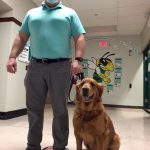In bad times every dog is a ‘very good dog
April 5, 2020

I have found myself looking at Bella with great envy these past few weeks. As I try to tamp down my panic and get work done, Bella naps in her dog bed next to my desk. At certain intervals, she gets up and fetches her fuzzy blue Yeti toy and delivers it by my feet, her brown eyes full of hope. How can she be so calm while the world is falling apart, I wonder? But I’m grateful. Her calmness brings me down a notch.
Emotional support is the dog job of our times. For our long-ago ancestors, dogs may have performed other functions, such as co-hunting or pulling sledges, but now they are full-time furry mental health practitioners. As dogs offer us their grounding presence and help us weather the emotional storm of a global pandemic, we should reconsider what we owe them.
Now that we are keeping our human networks at arm’s length, our need for emotional closeness with our pets has increased. This is a boon for many homed dogs, because these steadfast companions are the exact opposite of social distancers.
This inclination may be genetic. Scientists studying canine DNA have identified a gene for hyper-sociability; dogs are programmed for social closeness with humans, they need to be attached at the hip. Six feet, which is the new human definition of “personal space,” just doesn’t work for dogs. Being with us makes them calm and happy — just as being with them makes us calm and happy.
Our current solitude represents an opportunity to explore a certain one-sidedness in our social interactions with dogs. Why is “attention seeking” behavior in dogs — which is basically defined as them wanting our attention when we don’t feel like giving it to them — pathologized, with dogs sometimes punished and often medicated for it? Why do animal behaviorists advise us to ignore our dog’s advances?
I’m asking because now the shoe is on the other paw, and humans are suffering, in large numbers, from separation anxiety. We are separated from our friends, our social networks, and in many cases our parents or children. Maybe now we will get a taste of what millions of dogs are experiencing: the profound distress of being alone when we don’t want to be.
“Separation anxiety” is itself an example of the way we pathologize dogs’ behavior, which prevents us from understanding and empathizing with their experiences. A study published in Frontiers in Veterinary Science in January suggests that “separation anxiety” is not helpful clinically because a diverse range of frustrations and distress experienced by dogs who are left alone too much are clumped under one vague label. Might we gain more sympathy for the canine set today, as we learn that our own experiences of social isolation are complex and multi-layered and definitely uncomfortable?
We need the sympathy and safe companionship of dogs more now, as social distancing drives us into their furry paws. Those of us lucky enough to live with dogs already are reveling in more together time. The number of dogs being temporarily fostered has mushroomed over the past several weeks, as more and more people have been told to stay home. A New York times story described how one animal shelter sent out a call for 200 foster placements and was surprised to receive 2,000 applications.
This is wonderful and heartwarming. Yet I have some dark thoughts about it, too: Part of what is driving the fostering frenzy is the fact that people who work long hours away from the home and who have (rightfully, in my opinion) chosen not to have a dog are all of a sudden home all day. I fear that these dogs may get intensively loved on for a few weeks or months. And then what? Many people who are fostering a dog while they are off work or working from home, who are “using” a dog for emotional comfort and social contact during this crisis, will have to return the dog to the shelter when all is said and done.
These people will have given dogs in need a beautiful gift by sharing their homes. But the sad thing is that the spark of hope and security that might be kindled in these open-hearted dogs will be dimmed when they must go back to the shelter. And although the home environment is, on the average, going to be less stressful for a dog than the shelter environment, the transition from one to another can be very hard for dogs emotionally. Dogs shouldn’t be in shelters in the first place. When this is over we should do some collective soul-searching about a culture of dog ownership that leaves so many dogs adrift.
Even dogs who remain with their owners will struggle with adjustment when life returns to normal and people return to work. The rough consensus among trainers and dog advocates is that four hours alone is comfortable for most dogs, but long days home alone can compromise their welfare. Dogs’ frustration, anxiety, and loneliness can manifest in behaviors that, under non-COVID19 circumstances, humans have labeled pathological. If the dogs remain in the home, separated from people and not getting enough attention, we may see an uptick in those so-called “behavior problems.”
Though this crisis is an opportunity for dogs to get more attention from humans, it is also a time of great risk for them. Reports out of China include heartbreaking details of dogs and cats who were abandoned during the lockdown and who are now starving to death. Here in the United States, there already are reports of dogs being chained up outside, thrown out to the curb, or being dropped off at shelters because of unfounded fears that the virus causing COVID-19 could sicken them. In truth, the giant packages of toilet paper that people are fighting over at the store are more likely vectors for the virus than a dog.
And this is just the initial wave. If past disasters and economic downturns are reasonable precedent, the numbers of dogs relinquished to the shelters or abandoned on street corners and rural highways after this crisis will swell.
Panic and upheaval can bring out the best in people as well as the worst. This is especially true in relationship to our dogs. The crisis for dogs may look different and follow a different trajectory, but we need to be attentive to what it is like for them as well as for ourselves. The emotional ecosystem of dog and human is mutualistic and beneficial to both organisms. In times of crisis, they need us as much as we need them.


 When Luke Hengen’s diabetes worsened in his early twenties, it stripped him of the outdoor activities where the country kid felt at home. Countless wilderness adventures and years of hard-fought football games took a toll on his body, to the point where he could no longer sense when his blood sugar was too high or […]
When Luke Hengen’s diabetes worsened in his early twenties, it stripped him of the outdoor activities where the country kid felt at home. Countless wilderness adventures and years of hard-fought football games took a toll on his body, to the point where he could no longer sense when his blood sugar was too high or […] When middle school students return to class on Jan. 11, they’ll find a new face at the door: Daisy. Daisy is a therapy dog and the personal pet of Rob Kreger, principal of the Rock L. Butler Middle School. The five-year-old golden retriever is not a school pet or mascot, but rather a working dog […]
When middle school students return to class on Jan. 11, they’ll find a new face at the door: Daisy. Daisy is a therapy dog and the personal pet of Rob Kreger, principal of the Rock L. Butler Middle School. The five-year-old golden retriever is not a school pet or mascot, but rather a working dog […] Last March, Caroline Benzel, a third-year medical student, began to notice the stress and discomfort her nurse friends were feeling from the pressures of the ongoing Covid-19 pandemic. “[Personal protective equipment] can be really rough on the skin,” Benzel, 31, tells PEOPLE. Benzel and her 3-year-old Rottweiler, Loki (who’s also a therapy dog) hatched a […]
Last March, Caroline Benzel, a third-year medical student, began to notice the stress and discomfort her nurse friends were feeling from the pressures of the ongoing Covid-19 pandemic. “[Personal protective equipment] can be really rough on the skin,” Benzel, 31, tells PEOPLE. Benzel and her 3-year-old Rottweiler, Loki (who’s also a therapy dog) hatched a […] When Stanley the miniature fox terrier’s owner passed away, the little dog started a ‘paw-some’ new role – bringing puppy love to some of the Gold Coast’s oldest residents. After Carinity Cedarbrook Diversional Therapist Julianne Staff adopted Stanley, he began visiting the aged care community at Mudgeeraba as a therapy dog. Therapy dogs help to […]
When Stanley the miniature fox terrier’s owner passed away, the little dog started a ‘paw-some’ new role – bringing puppy love to some of the Gold Coast’s oldest residents. After Carinity Cedarbrook Diversional Therapist Julianne Staff adopted Stanley, he began visiting the aged care community at Mudgeeraba as a therapy dog. Therapy dogs help to […] A nonprofit is providing an unusual form of therapy for those on the front lines of the coronavirus pandemic – puppy cams! “You spend five minutes with a puppy and try not to smile,” said registered nurse Robin Lingg Lagrone. Lingg Lagrone says watching little furballs wag their tails and prance on their paws helps […]
A nonprofit is providing an unusual form of therapy for those on the front lines of the coronavirus pandemic – puppy cams! “You spend five minutes with a puppy and try not to smile,” said registered nurse Robin Lingg Lagrone. Lingg Lagrone says watching little furballs wag their tails and prance on their paws helps […] When Moore County’s school doors were abruptly closed earlier in 2020, two- and four-legged volunteers from the Moore County Citizens’ Pet Responsibility Committee (PRC) were in their 12th year of presenting a six-session Pet Responsibility Education Program for fourth-graders. The PRC quickly shifted gears and placed its program materials online as part of a home […]
When Moore County’s school doors were abruptly closed earlier in 2020, two- and four-legged volunteers from the Moore County Citizens’ Pet Responsibility Committee (PRC) were in their 12th year of presenting a six-session Pet Responsibility Education Program for fourth-graders. The PRC quickly shifted gears and placed its program materials online as part of a home […]